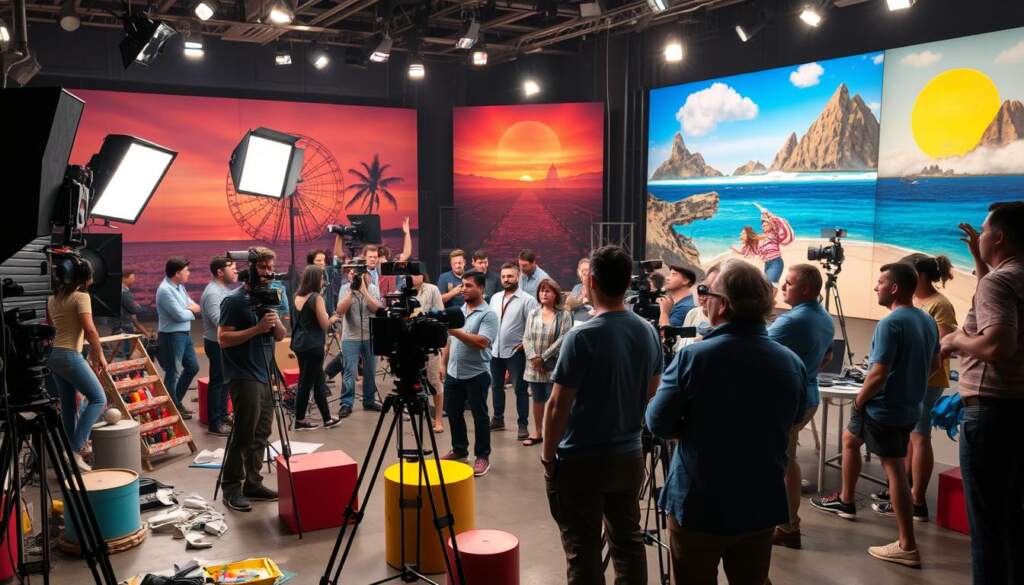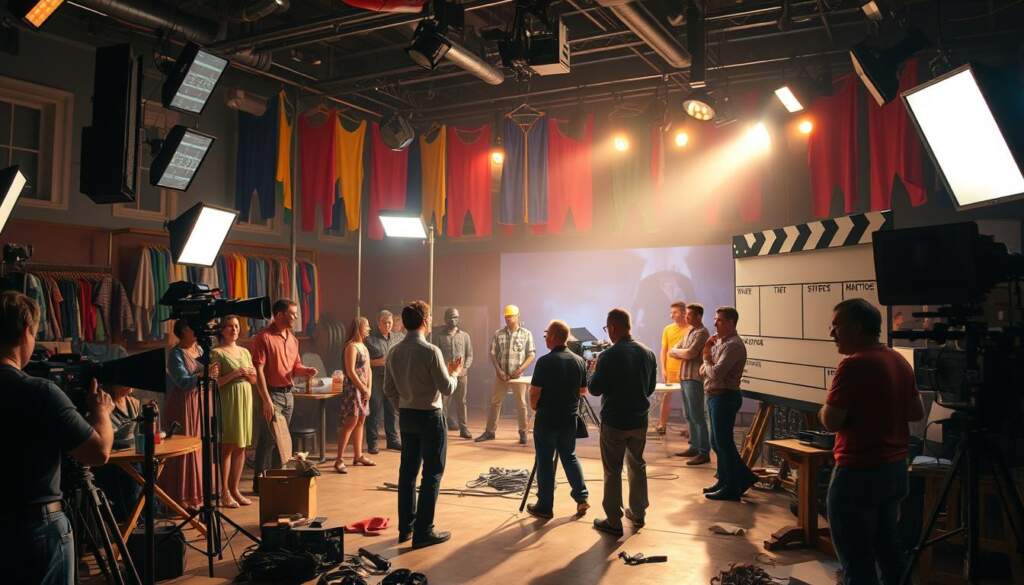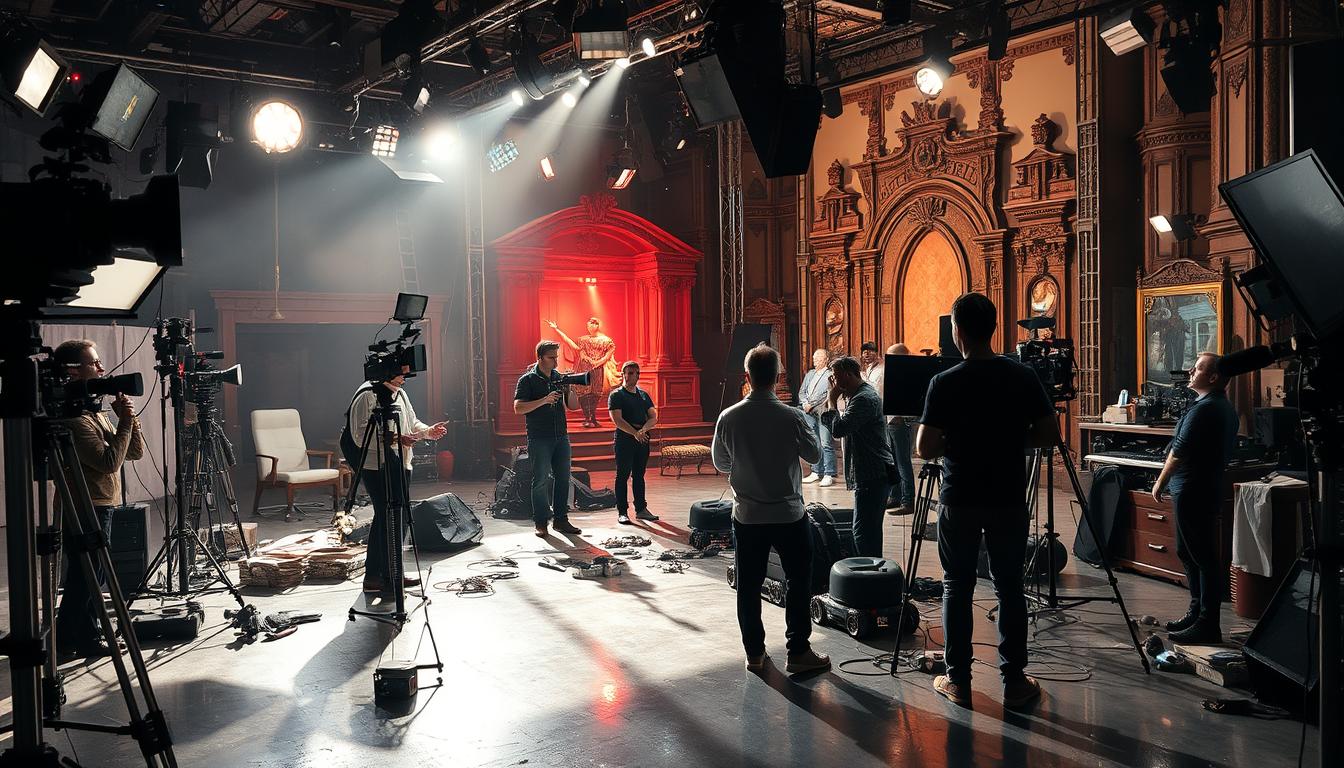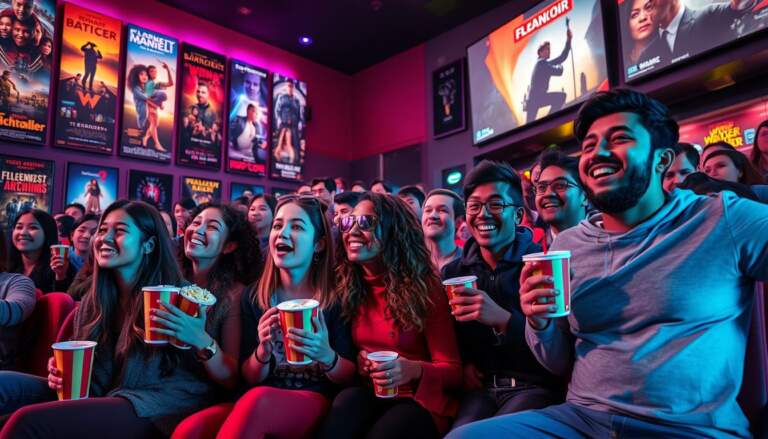Embark on a fascinating journey to unveil the film production secrets that transform creative visions into the cinematic creations that captivate audiences worldwide. This deep dive into the movie magic that happens off-screen will take you through the elaborate lifecycle of a film, from its inception to the moment it lights up the big screen.
From the colossal success of Avengers: Endgame, which grossed nearly $2.8 billion, to the quick and efficient productions that craft narratives in record time, the process of making a movie is as varied as it is intriguing12. Get ready to explore each stage of the process, garnished with real data on production timelines, budgets, and more, to understand the industry behind your favorite films2.
Key Takeaways
- Discover the intricate stages of film production, from conception to completion.
- Learn about the balancing act of budgets, with examples like Avengers: Endgame requiring a break-even point well beyond its $356 million production budget1.
- Understand the role of digitalization, as streaming services disrupt traditional DVD and video markets1.
- Gain insight into the creative aspects of movie making such as scripting, casting, and scouting locations2.
- Appreciate the complexity behind special effects and post-production editing, crucial for the final cinematic creation2.
- Explore the success metrics within the film industry, seeing how top-performing movies like Avengers: Endgame shape industry trends1.
- Grasp the scope of collaboration necessary to bring a movie to life, involving hundreds to thousands of skilled individuals2.
Pre-Production: The Genesis of Blockbusters
The art of crafting a blockbuster movie begins way before a single camera rolls. The meticulous pre-production phase sets the foundation for everything that follows, highlighting the paramount importance of film script development, casting, scouting, and budgeting. In 2023, Disney’s investment of $10.5 billion in original content underlines a booming era for film production3.
Scriptwriting and Storyboarding: Sketching the Scenes
Every monumental film starts with a compelling story. Writers and storyboard artists work hand in hand to translate imaginative scripts to visual blueprints, a phase vital for mapping out scenes and envisioning the cinematic journey. In this realm, technologies such as AI have revolutionized the traditional processes, offering creative new ways to enhance the narrative’s visual appeal3.
Casting the Icons: Assembling the Cast
The casting process is not just about finding actors but about discovering the right chemistry between them. This step is crucial in bringing characters and stories to life, ensuring that the cast resonates with the envisioned characters of the script. As the industry evolves, the approach to casting has also embraced digital platforms, leveraging the vast reach of social media to engage potential talent and audiences alike3.
Location Scouting: Hunting for Perfect Settings
Securing location permits is a critical task in movie production, involving meticulous scouting to find sites that perfectly align with the script’s demands. These locations must not only inspire the right ambiance but also accommodate complex logistic requirements of film production3. Recent advancements in technology have also allowed for virtual scouting, enabling directors and producers to explore spots in unprecedented ways.
Budgeting and Financing: Fueling the Movie’s Engine
Movie budget planning is perhaps the most crucial economic facet of film production. It involves careful assessment of potential costs and securing adequate funding to cover everything from set construction and actor salaries to post-production processes. With the ballooning costs associated with modern blockbusters, efficient budget management is more critical than ever3. In fact, innovative financing models and partnerships are increasingly commonplace, reflecting the industry’s adaptability in a digital age.
Understanding the processes behind film privacy policies is also essential, as blockbuster productions involve handling massive amounts of data, from cast and crew personal details to high-definition film footage. Such data must be managed responsibly to protect privacy and comply with global standards3.
Production Magic: The Art of Movie Making
The heart of cinematic storytelling beats loudest during the production stage, where the synergy of on-set filmmaking, capturing performances, and crew coordination molds the narrative into a visual spectacle. This phase is marked by dynamic collaboration among diverse teams, each contributing to the seamless flow of the filmmaking process45.


From lighting technicians setting the mood to directors shaping scenes with actors, on-set filmmaking exemplifies the essence of production. The meticulous planning observed during the pre-production stage5 paves the way for efficient shooting schedules, ensuring that every scene is impeccably orchestrated to capture performances that resonate with audiences.
Crew coordination becomes indispensable, especially when handling complex sequences that demand precise timing and resource management. The production stage, often extending over several months, is where the foundational visions of scriptwriters and directors materialize through the relentless efforts of the entire film crew4.
| Aspect | Importance | Details |
|---|---|---|
| Pre-production | Critical for smooth execution | Finalizes budgets, casting, and logistical details4. |
| Production | Core phase | Actual filming, key for capturing desired performances4. |
| Post-production | Polishing the final product | Editing, visual effects, and final touches are added5. |
This phase not only requires adept management of physical resources but also demands agility in problem-solving to address unanticipated challenges, thereby ensuring the project remains on track and within budget6. Collaboration among different departments plays a crucial role in this, as effective communication can significantly reduce potential delays and extra costs6.
Ultimately, on-set filmmaking during production is a critical juncture where the film starts to come alive. Through adept crew coordination and the flawless capturing of performances, the production stage encapsulates the magic of movie making, turning myriad elements into cohesive cinematic experiences.
Behind the Scenes: How Your Favorite Movies Are Made
Diving into the world of movies, you swiftly realize the level of creative dedication presented on sets of popular productions like “House of the Dragon” and “Wakanda Forever.” Actors undergo significant transformations, embodying characters that leave lasting impressions on audiences. For instance, the use of advanced green screen technology has become a staple in creating such compelling visual narratives, integrating real performances with virtual environments7.
Moreover, film set anecdotes often uncover the sheer complexity of movie production insights. Legendary Hollywood stuntmen complete daring feats that most only see as thrilling moments on the screen, reflecting years of expertise and countless unseen rehearsals7. Additionally, Marvel movies tease the observant viewer with hidden details that encourage multiple viewings to catch them all, a clever tactic to enhance fan engagement7.


Horrific on-set accidents and eerie occurrences during the shootings of horror movies provide a chilling layer to the genre, often making the behind-the-scenes stories as terrifying as the movies themselves. Such events have been documented to occur about 10 times, merely underscoring the unpredictable nature of filming in this genre7.
| Movie Genre | Hidden Details | Terrifying Incidents |
|---|---|---|
| Adventure (Indiana Jones) | 31 hidden insights7 | 12 deaths on sets7 |
| Superhero (Iron Man) | 26 overlooked elements7 | 10 eerie events7 |
| Superhero (Captain America) | 24 intricate details7 |
Conclusively, exploring how high frame rate filming changes the viewer’s experience offers another layer of understanding the advancements in the industry. This comparison prompts a deeper appreciation of how technology shapes storytelling7.
Each piece of trivia, each carefully organized scene, and even the accidents that occur contribute to the rich tapestry of filmmaking. These movie production insights and film set anecdotes collectively offer a more immersive view into the artistry and challenges behind the cinematic creations cherished worldwide.
The Role of Directors: Steering the Cinematic Ship
The fusion of directorial leadership, set collaboration, and narrative consistency forms the backbone of successful filmmaking. Directors not only guide a film’s artistic vision but also ensure that every element coheres seamlessly from start to finish.
Decision-Making on Set: The Director’s Vision
At the heart of a movie’s production is the director, whose vision shapes every aspect of the narrative. It’s their directorial leadership that translates the script into compelling visual storytelling, guiding the emotional tone and pacing of the film. Directors are responsible for steering the project and ensuring that each scene and line resonates with the intended emotional impact8. This involves meticulous shot composition and on-set decision-making that encapsulates the essence of the script9.
Collaboration with the Crew: United for Creativity
Effective set collaboration is pivotal as directors work closely with various crew members, from cinematographers who frame their vision on screen to production designers who bring each setting to life. The synergy between the director and crew, including sound designers and composers, enhances the viewer’s experience through carefully crafted audio-visual elements8. This teamwork extends to producers, who balance the artistic and business aspects of filmmaking, ensuring that the director’s creative goals are met within financial and scheduling constraints9.
Maintaining the Narrative: Keeping the Story Flowing
Maintaining narrative consistency across the scope of a production challenges directors to keep the storyline coherent and engaging. Film editors play a crucial role here, joining clips to ensure the narrative flows smoothly and retains the audience’s engagement throughout the film8. Each scene must seamlessly connect with the next, maintaining the integrity and continuity of the story line as envisioned by the director9.
Through directorial leadership, set collaboration, and an unwavering commitment to narrative consistency, directors truly are the captains of the cinematic ship, making pivotal decisions that influence every aspect of the filmmaking process. Their role is indispensable in sculpting standout films that resonate with audiences around the globe.
Special Effects and CGI: Crafting Visual Wonders
The ever-evolving realm of cinema continually harnesses the dual powers of CGI technology and practical effects to create spectacular visual narratives. From the seamless integration of realistic creatures to the architectural marvels set in fantastical worlds, the industry’s push towards visual effects innovation shapes how stories are told on screen.
Special Effects Innovations: From Practical to Digital
The harmonious blend of traditional practical effects with cutting-edge CGI technology has allowed filmmakers to broaden their creative horizons. In the 1990s, the advent of computer-generated imagery transformed the landscape of special effects in the movie industry, leading to blockbuster hits like “The Lord of the Rings” and “Avatar”10. Georges Méliès, known as the father of special effects, used inventive contraptions and artistic effects in early cinema, setting a foundation that would evolve into today’s sophisticated CGI implementations11.
CGI Evolution: Creating New Realities
Films like “Gravity” and “Interstellar” have not only captivated audiences with their compelling narratives but also with their groundbreaking use of CGI technology to create visually stunning cinematic experiences. “Gravity” relied predominantly on computer-generated imagery to portray realistic space environments, while “Interstellar” collaborated with physicists to generate mathematically accurate images of alien worlds and black holes11.
Behind the Scenes: How The Way of Water and Iron Man Came to Life
Movies such as “Avatar: The Way of Water” and “Iron Man” exemplify the pinnacle of CGI technology, where digital environments and characters are so detailed and lifelike that they blur the line between animation and reality. This precision in CGI not only enhances the visual appeal but also significantly contributes to the storytelling, making the fantastical elements more immersive and believable.
| Movie | Special Effects Techniques | CGI Implementation |
|---|---|---|
| Kong: Skull Island | Animatronics, Physical Set Construction | High-resolution CGI for creatures |
| Beauty and the Beast | Prosthetics, Motion Capture | Detailed character rendering |
| The Wizard of Oz | Sepia Tones, Muslin Fabric Tornado | Melting Witch Effect |
The Crucial Role of Editing: Piecing Together the Masterpiece
In the world of filmmaking, the editing process serves as the crucial bridge between raw production and the audience, transforming unstructured scenes into a captivating narrative. This stage, often underappreciated, truly determines how the story is communicated and received.
Post-Production Process: From Rough Cut to Final Edit
Editing begins with the assembly cut, essential for establishing the film’s initial flow, which is then meticulously refined into what is known as the final cut. This stage is where directors and editors scrutinize every frame to ensure continuity and pacing. For example, directors like Steven Spielberg and George Lucas, due to their substantial industry reputation, command the final say in this editing process12. The intricate craft of final cut creation involves selecting the most compelling takes and piecing them together to both engage and enchant the viewer.
Sound Design and Scoring: Composing the Movie’s Beat
The sound design importance cannot be overstressed in its role to complement visual storytelling. The sound landscape of a film, comprising dialogue, ambient sounds, and the musical score, creates a rich auditory experience that significantly enhances emotional impact. From the iconic scores of “Star Wars” to the intricately layered soundscapes of “Inception,” sound design and scoring serve as the backbone of a film’s atmosphere. Directors often work with seasoned sound editors to synchronize music with scenes, heightening moments of tension or triumph13.
Furthermore, modern advancements in digital sound technology have allowed sound designers to experiment with and refine audio elements more dynamically, tailoring them precisely to the visuals on screen14.
Visual Effects: Final Touches on the Immersive Experience
Visual effects in filmmaking not only embellish reality but make the fantastical plausible, enveloping the viewer in the movie’s universe. These effects, when edited thoughtfully, complement the director’s vision, often turning a simple scene into a visual marvel. The role of graphic editing amplifies the emotive quality, utilizing visual contrasts to heighten drama or support narrative shifts14. For instance, the seamless integration of CGI in “Avatar” showcases how editing expertise can result in a fully immersive viewer experience that is visually coherent and emotionally gripping.
| Edit Type | Technique | Impact |
|---|---|---|
| Continuity | Seamless narrative flow | Enhances story coherence |
| Montage | Varied shots to show passage of time | Builds complex concepts quickly |
| Graphic | Visual contrasts and juxtapositions | Aesthetic impact and symbolic depth |
Conclusion
The cinematic journey we’ve embarked on in this behind-the-scenes exploration has uncovered the intricate tapestry of skills, creativity, and painstaking efforts that bring stories to life on the silver screen. From concept to curtain call, each phase of the movie production process, including Development, Pre-production, Production, Post-production, and Distribution & Marketing, plays a pivotal role in a film’s genesis and its ultimate success15. By unraveling the film industry secrets, we’ve seen how the melding of theme, genre, characters, and narrative structure, along with technical prowess in cinematography, editing, and sound design, form the crux of captivating filmmaking15.
Understanding these elements through a formal film analysis invites viewers to appreciate the nuanced components that create the coalesced masterpiece they enjoy16. The harmonious collaboration among hundreds of professionals, sometimes spanning years, is testament to the industry’s unwavering commitment to storytelling excellence15. The right combination of creative elements not only ensures that movies remain appealing but also secures their place in the annals of film history, as did the timeless classics from the American Film Institute’s notable mentions15.
As we conclude this article, it’s evident that the film industry’s allure is not solely due to the glamour of red carpets and premieres but also stems from the complex synergy of passionate individuals executing their craft in the realms of screenwriting, casting, and filmmaking techniques such as camera angles, lighting, and sound design17. Let us walk away with a deep-seated respect and a heightened awareness for the art and the creative forces that fuel the remarkable cinematic journey, light up screens worldwide, and shape our cultural narrative.
FAQ
What are the key steps in the pre-production phase of a movie?
How do special effects and CGI contribute to the movie-making process?
What happens during the production phase of a film?
Can you explain the role of directors on a movie set?
How is the post-production phase different from the editing process?
What is the importance of sound design and scoring in film production?
How does a typical casting process work in film production?
What are some common challenges faced during location scouting?
Why is budgeting and financing a critical step in making a movie?
How do practical effects integrate with CGI, and why are they both important?
What is the significance of maintaining narrative consistency in a film?
How do behind-the-scenes images and footage contribute to movie-making?
Source Links
- Behind the Scenes: The Business of Making Movies — Wesleyan Business Review – https://www.wesleyanbusinessreview.com/recents/behind-the-scenes-the-business-of-making-movies
- How Are Movies Made? – https://www.wonderopolis.org/wonder/how-are-movies-made
- The World of Film Production: How to Make a Movie – https://www.lafilm.edu/blog/the-world-of-film-production/
- The 5 Stages of Production | Cinemagic Blog – https://www.cinemagics.com/post/5-stages-of-production
- The Art and Craft of Film-making: A Journey into the World of Cinema – https://www.linkedin.com/pulse/art-craft-film-making-journey-world-cinema-maged-samuel
- Understanding the basics of film production: Lights, camera, action – APAC – https://apac.edu.au/blog/understanding-basics-of-film-production/
- Behind the Scenes – https://entertainment.howstuffworks.com/behind-the-scenes-channel.htm
- Producer, Director, and Crew Responsibilities Explained – https://www.needafixer.com/blog/understanding-the-responsibilities-of-producers-directors-and-crew/
- Producer vs Director – Roles, Responsibilities and Differences – https://rfm.rezaid.co.uk/post/producer-vs-director
- Behind the Scenes of Blockbuster Movies: Special Effects and Movie Magic – https://medium.com/@poppulsenewsmag/behind-the-scenes-of-blockbuster-movies-special-effects-and-movie-magic-0994306524fb
- Special Effects In Movies: Everything You Need to Know – NFI – https://www.nfi.edu/special-effects-in-movies/
- The Process and Roles in Film Editing – https://www.dummies.com/article/academics-the-arts/performing-arts/film/editing-your-movie-putting-one-frame-in-front-of-the-other-266962/
- Editing Insights and Analysis of Six Masterpieces – https://blog.frame.io/2018/03/12/studying-6-editing-masterpieces/
- Editing Film Definition : The Invisible Storytellers Of Cinema – ITU Online – https://www.ituonline.com/blogs/editing-film-definition/
- Conclusion: What’s So Exciting about Movies? – Novice Answers – https://milnepublishing.geneseo.edu/exploring-movie-construction-and-production/back-matter/conclusion-whats-so-exciting-about-movies-novice-answers/
- Resources – How to Write a Film Analysis – The Writing Place – https://www.writing.northwestern.edu/resources-how-to-write-a-film-analysis/
- Behind the Scenes: How Your Favorite Movies Are Made – View Star Box – https://viewstarbox.com/behind-the-scenes-how-your-favorite-movies-are-made/



